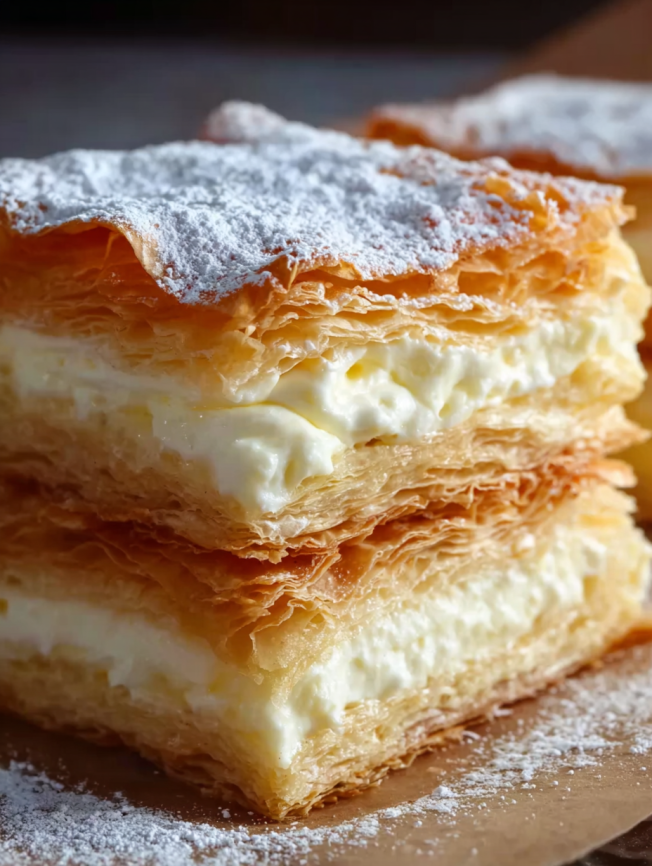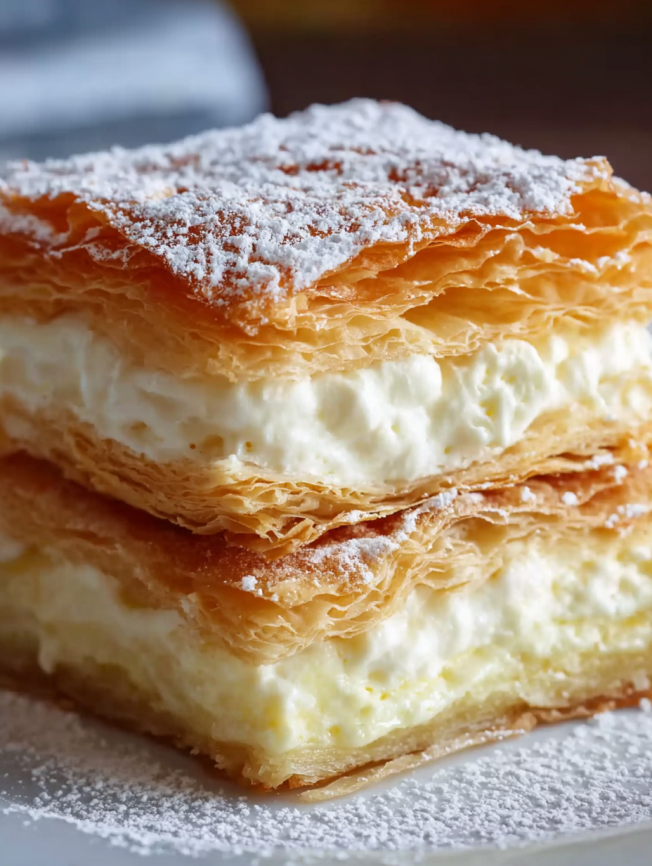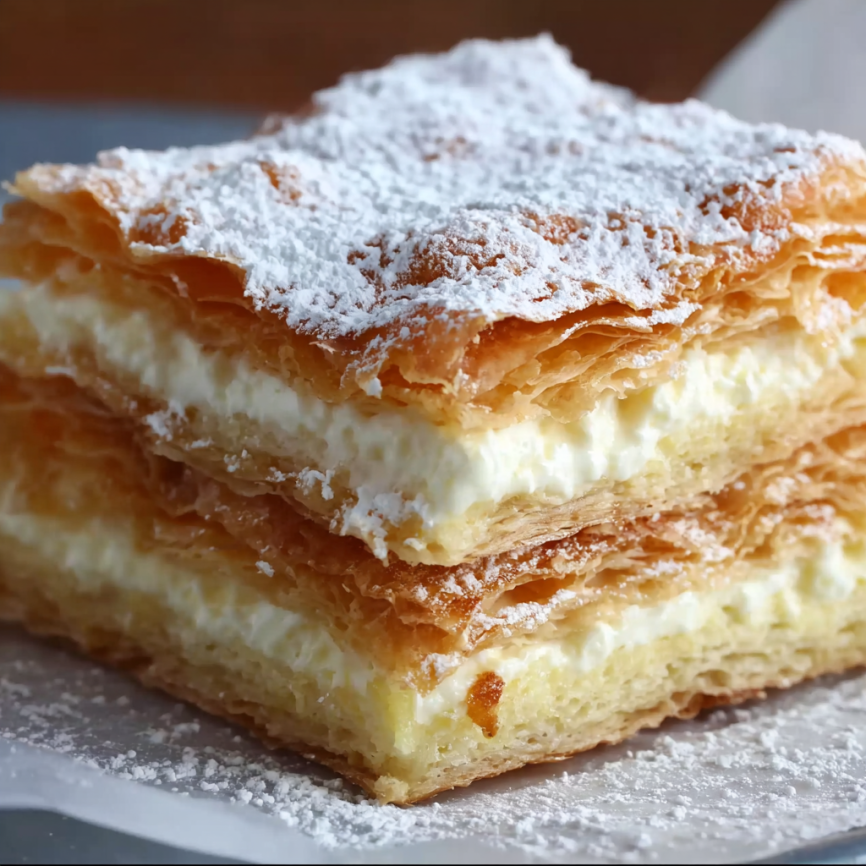Growing up in a Polish household, Sunday afternoons often meant the sweet aroma of baking pastries wafting through our kitchen. Among all the treasured family recipes, Karpatka held a special place at our table. This beloved dessert, with its golden puff pastry layers and silky vanilla cream, represents the heart of Polish baking tradition. The name itself comes from the Carpathian Mountains, reflecting the cake’s rustic, mountainous appearance that belies its sophisticated flavor.
Why Karpatka Will Become Your New Favorite Dessert
A Taste of Authentic Tradition
This classic Polish dessert has been delighting families for generations. Unlike many modern desserts, Karpatka relies on simple, honest ingredients that come together to create something truly magical. Each bite delivers a perfect balance of crispy pastry and smooth, velvety cream.
Surprisingly Simple to Master
Despite its impressive appearance, Karpatka doesn’t require advanced pastry skills. The recipe uses store-bought puff pastry as a shortcut, making it accessible to home bakers while still delivering that authentic, homemade taste that makes this dessert so special.
Perfect for Entertaining
Whether you’re hosting a dinner party or bringing dessert to a family gathering, Karpatka always impresses. The generous portion size feeds a crowd, and its elegant presentation makes it suitable for both casual and formal occasions.
Make-Ahead Convenience
Actually improving with time, this dessert can be prepared hours or even a day in advance. The flavors meld beautifully as it chills, making it an ideal choice for busy hosts who want to prepare stunning desserts without last-minute stress.
Essential Ingredients & Shopping Guide
Pastry Foundation
- 500g puff pastry – Choose high-quality frozen pastry for best results; thaw according to package directions
- Powdered sugar for dusting – Creates the traditional snowy mountain peak appearance
Luxurious Vanilla Cream
- 500ml whole milk – Full-fat milk creates the richest, most satisfying cream
- 200g granulated sugar – Provides sweetness and helps thicken the custard
- 4 large eggs – Room temperature eggs blend more easily and create smoother cream
- 40g cornstarch – The secret to achieving that perfect, spoon-able consistency
- 100g unsalted butter – Adds richness and creates the signature silky texture
- 1 teaspoon vanilla extract – Pure vanilla extract delivers the best flavor
Equipment You’ll Need
A large baking sheet, rolling pin, heavy-bottomed saucepan, whisk, and fine-mesh strainer will ensure success. Having these tools ready before you begin makes the process smooth and enjoyable.
Step-by-Step Instructions for Perfect Karpatka
Preparing Your Workspace
Begin by preheating your oven to 200°C (400°F). Line a large baking sheet with parchment paper, ensuring it covers the entire surface. This preparation step prevents sticking and makes removal effortless.
Creating the Pastry Layers
Remove the puff pastry from refrigeration and allow it to soften slightly for easier handling. Divide the pastry into two equal portions, then roll each piece into rectangles of approximately 30cm x 20cm. The pastry should be rolled to about 3mm thickness for optimal puffing and crispness.
Transfer both pastry rectangles to your prepared baking sheet. Using a fork, create small holes across the surface – this technique, called docking, prevents excessive puffing and creates a more even texture.
Achieving Golden Perfection
Bake the pastry layers for 20-25 minutes until they achieve a beautiful golden-brown color. The pastry should sound hollow when tapped gently and feel crisp to the touch. Remove from oven and cool completely on wire racks before assembly.
Crafting the Signature Cream
Building the Base
In a medium saucepan, combine milk, sugar, and vanilla extract. Heat over medium heat, stirring occasionally, until the mixture just begins to simmer. Meanwhile, prepare your egg mixture by whisking the eggs thoroughly in a separate bowl.
The Tempering Technique
Gradually add the warm milk mixture to the beaten eggs, whisking constantly to prevent curdling. This tempering process is crucial for achieving smooth, lump-free cream. Pour the entire mixture back into the saucepan.
Achieving Perfect Consistency
Whisk the cornstarch with a small amount of cold milk until smooth, then add this slurry to the custard base. Cook over low heat, stirring continuously, until the mixture thickens to coat the back of a spoon. This process typically takes 8-10 minutes.
Remove from heat and immediately whisk in the butter until completely melted and incorporated. Strain the cream through a fine-mesh sieve to ensure silky smoothness, then cover with plastic wrap pressed directly onto the surface to prevent skin formation.

Assembly and Presentation Techniques
Creating the Perfect Layers
Once both pastry layers and cream have cooled completely, begin assembly. Place one pastry rectangle on your serving platter, then spread the vanilla cream evenly across the surface, leaving a small border around the edges.
Carefully position the second pastry layer on top, pressing gently to ensure good contact without squeezing out the cream. The finished cake should have clean, defined layers that showcase the beautiful contrast between golden pastry and pale cream.
The Finishing Touch
Dust the top generously with powdered sugar using a fine-mesh sieve. This traditional finishing touch not only adds sweetness but creates the characteristic “snowy mountain” appearance that gives Karpatka its distinctive look.
Serving Suggestions and Flavor Pairings
Traditional Presentation
Serve Karpatka chilled, cut into neat rectangles using a sharp, serrated knife. Clean the knife between cuts to maintain crisp, clean edges. Each serving should showcase the beautiful layers and creamy filling.
Elegant Accompaniments
Fresh berries make an excellent accompaniment, providing color contrast and tartness that balances the rich cream. A drizzle of berry coulis or a small scoop of fruit sorbet can elevate this traditional dessert for special occasions.
Coffee Culture Connection
In Poland, Karpatka is traditionally enjoyed with strong coffee or tea. The bitter notes complement the sweet cream perfectly, creating a balanced and satisfying dessert experience.
Creative Variations and Flavor Twists
Chocolate Lovers’ Version
Transform the basic recipe by adding 2 tablespoons of cocoa powder to the cream for a chocolate variant. Alternatively, spread a thin layer of melted chocolate between the pastry and cream for added richness.
Fruit-Forward Options
Incorporate fresh fruit by layering thinly sliced strawberries or peaches with the cream. The fruit adds natural sweetness and creates beautiful visual appeal when the cake is sliced.
Seasonal Adaptations
During autumn, consider adding a pinch of cinnamon or cardamom to the cream for warm, spiced notes. Summer versions might feature lemon zest in the cream for a bright, refreshing twist.
Storage and Make-Ahead Strategies
Optimal Storage Methods
Store assembled Karpatka in the refrigerator, covered with plastic wrap or in an airtight container. The dessert maintains its quality for up to three days, though it’s at its peak within the first 24 hours.
Make-Ahead Planning
Both components can be prepared separately in advance. Bake pastry layers up to two days ahead, storing them in airtight containers at room temperature. The cream can be made up to one day in advance and refrigerated with plastic wrap pressed directly onto the surface.
Serving Temperature Tips
For best flavor and texture, remove Karpatka from the refrigerator 15-20 minutes before serving. This slight tempering allows the cream to soften while maintaining the pastry’s crispness.
Professional Tips and Troubleshooting
Pastry Perfection Secrets
Ensure your puff pastry remains cold while working with it to achieve maximum rise. If the pastry becomes too warm, refrigerate it for 10-15 minutes before continuing.
Cream Consistency Solutions
If your cream becomes lumpy during cooking, immediately remove it from heat and whisk vigorously. Straining through a fine-mesh sieve will remove any remaining lumps and ensure smoothness.
Assembly Timing
Never assemble Karpatka with warm components, as this will cause the pastry to become soggy and the cream to thin. Patience in allowing everything to cool properly ensures the best results.

Frequently Asked Questions
Can I make Karpatka without cornstarch?
While cornstarch is preferred for its neutral flavor and excellent thickening properties, you can substitute with an equal amount of all-purpose flour. However, whisk it thoroughly with cold milk before adding to prevent lumps, and expect a slightly different texture.
What if my puff pastry doesn’t rise properly?
Several factors can prevent proper rising: expired pastry, overhandling, or insufficient oven temperature. Ensure your pastry is fresh, handle it minimally, and verify your oven temperature with a thermometer for accuracy.
How do I prevent the cream from curdling?
Temperature control is key. Always temper the eggs by adding warm milk gradually while whisking constantly. Additionally, keep the heat at medium-low and stir continuously during cooking to prevent overheating.
Can I freeze Karpatka?
While technically possible, freezing significantly affects the texture of both pastry and cream. The pastry loses its crispness, and the cream may separate slightly upon thawing. Fresh preparation yields far superior results.
Why is my Karpatka soggy?
Sogginess typically results from assembling the dessert while components are still warm, or from storing it uncovered in the refrigerator. Always ensure complete cooling before assembly and proper storage afterward.
How far in advance can I assemble Karpatka?
For optimal texture contrast, assemble no more than 24 hours before serving. However, the dessert remains delicious for up to three days, though the pastry will gradually soften as it absorbs moisture from the cream.
Recipe Summary:
- Total Time: 55 minutes
- Yield: 12 generous servings
- Diet: Vegetarian
- Skill Level: Intermediate
- Best Served: Chilled, within 24 hours of assembly
Nutrition Information (per serving):
- Calories: 250
- Total Fat: 12g (Saturated: 7g, Unsaturated: 3g)
- Carbohydrates: 30g
- Fiber: 1g
- Protein: 4g
- Sugar: 15g
- Sodium: 50mg
- Cholesterol: 100mg

